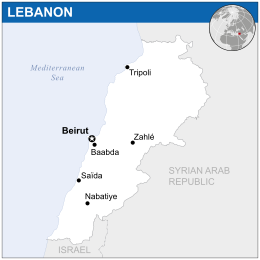
Back Ливан Abkhazian Lubnan ACE Ливан ADY Libanon Afrikaans Libanon ALS ሊባኖስ Amharic Lebanon AMI Liban AN Libanus ANG लेबनान ANP
Republic of Lebanon | |
|---|---|
| Anthem: كلّنا للوطن (Arabic) Koullouna lilouataan lil oula lil alam English: All of us! For our Country! | |
 Location of Lebanon (in green) | |
 | |
| Capital and largest city | Beirut 33°54′N 35°32′E / 33.900°N 35.533°E |
| Official languages | Arabic[nb 1] |
| Recognised languages | |
| Local vernacular | Lebanese Arabic |
| Ethnic groups | |
| Religion (Estimated[nb 4]) |
|
| Demonym(s) | Lebanese |
| Government | Unitary confessionalist parliamentary republic[7] |
| Michel Aoun | |
| Najib Mikati | |
| Nabih Berri | |
| Legislature | Parliament |
| Establishment | |
| 1 September 1920 | |
| 23 May 1926 | |
• Independence declared | 22 November 1943 |
• French mandate ended | 24 October 1945 |
• Withdrawal of French forces | 17 April 1946 |
| 24 May 2000 | |
| 30 April 2005 | |
| Area | |
• Total | 10,452 km2 (4,036 sq mi) (161st) |
• Water (%) | 1.8 |
| Population | |
• 2021 estimate | 5,592,631[8][9] (109th) |
• Density | 560/km2 (1,450.4/sq mi) (21st) |
| GDP (PPP) | 2020 estimate |
• Total | $91 billion[10] |
• Per capita | $11,562[10] (66th) |
| GDP (nominal) | 2020 estimate |
• Total | $18 billion[10] (82nd) |
• Per capita | $2,745[10] |
| Gini (2011) | medium |
| HDI (2019) | high · 92nd |
| Currency | Lebanese pound (LBP) |
| Time zone | UTC+2 (EET) |
• Summer (DST) | UTC+3 (EEST) |
| Driving side | right[13] |
| Calling code | +961[14] |
| ISO 3166 code | LB |
| Internet TLD | .lb |
Lebanon is a country in the Middle East, in Western Asia, next to the Mediterranean Sea. It has borders with Israel to the south and Syria to the east and north. It also shares a maritime border with Cyprus to the northwest.
Cite error: There are <ref group=nb> tags on this page, but the references will not show without a {{reflist|group=nb}} template (see the help page).
- ↑ "Lebanon 2017 International Religious Freedom Report" (PDF). United States Department of State. Retrieved 22 August 2021.
- ↑ "International Religious Freedom Report 2008: Lebanon". United States Department of State. 19 September 2008. Retrieved August 22, 2021.
- ↑ "International Religious Freedom Report 2010: Lebanon". United States Department of State. Archived from the original on 23 November 2010. Retrieved 22 August 2021.
- ↑ "International Religious Freedom Report for 2012: Lebanon". United States Department of State. Retrieved 22 August 2021.
- ↑ Meguerditchian, Van (15 February 2013). "Minority sects demand greater representation in Parliament". The Daily Star Lebanon. Archived from the original on 5 August 2021. Retrieved 22 August 2021.
- ↑ Haddad, Antoine (September 2006). "Evangelicals in Lebanon". Evangelical Times. Retrieved 22 August 2021.
- ↑ "The Lebanese Constitution" (PDF). Presidency of Lebanon. Archived from the original (PDF) on 19 January 2012. Retrieved 20 August 2011.
- ↑ "World Population Prospects 2022". population.un.org. United Nations Department of Economic and Social Affairs, Population Division. Retrieved July 17, 2022.
- ↑ "World Population Prospects 2022: Demographic indicators by region, subregion and country, annually for 1950-2100" (XSLX). population.un.org ("Total Population, as of 1 July (thousands)"). United Nations Department of Economic and Social Affairs, Population Division. Retrieved July 17, 2022.
- ↑ 10.0 10.1 10.2 10.3 "Lebanon". International Monetary Fund. Retrieved 20 October 2019.
- ↑ "Gini Index coefficient". CIA World Factbook. Retrieved 16 July 2021.
- ↑ "Human Development Report 2019". United Nations Development Programme. 10 December 2019. Archived from the original (PDF) on 30 April 2020. Retrieved 10 December 2019.
- ↑ "Driving in Lebanon". adcidl.com. Archived from the original on 17 January 2013. Retrieved 17 January 2013.
- ↑ Cite error: The named reference
ciawas used but no text was provided for refs named (see the help page).

